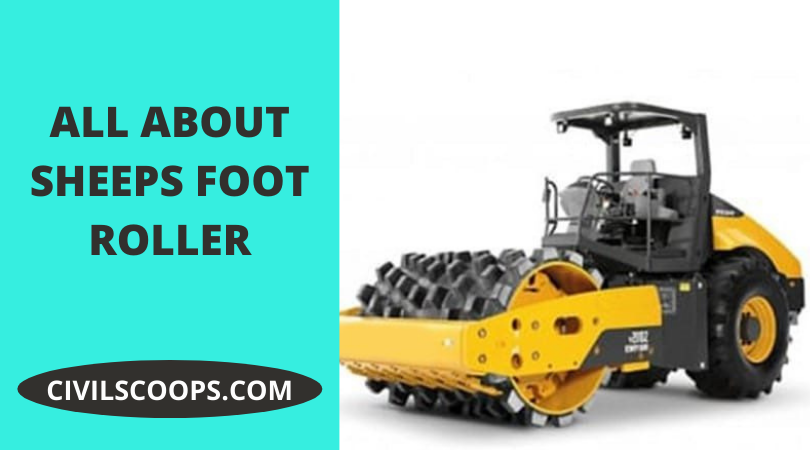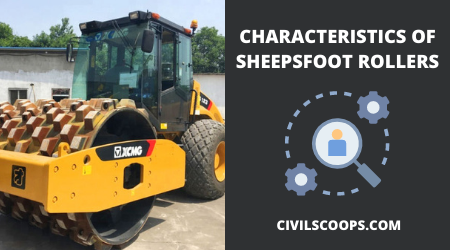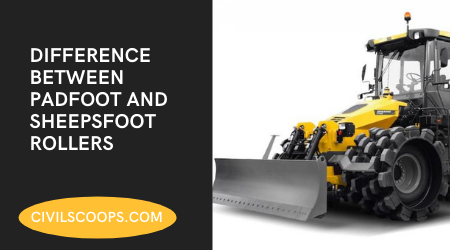What Is Sheepsfoot Roller? | Characteristics of Sheepsfoot Rollers | Difference Between Padfoot and Sheepsfoot Rollers

Table of Contents
What Is Sheepsfoot Roller?
Sheepsfoot rollers are vibratory compacting devices that are mostly used for soil and aggregate compaction. It is one of the most widely used soil compactors for builders and contractors worldwide. The sheepsfoot roller is a form of self-propelled heavy machinery that is usually mowed and operates in a static position. Depending on the condition of the soils, this sort of roller is available in a range of sizes.
It uses almost hoof-like structures protruding from a roller to apply pinpoint pressure all over the soil. which acts as a kneading agent for The drum’s protruding studs resemble a sheepsfoot. The size of the teeth varies marginally from one sheepsfoot roller to the next and depends on the requirements of various manufacturers. It is very useful for compaction of plastic soils such as silt or clay.
They’re excellent for compacting dirt and silty clay during road building. The weight of the sheepsfoot drum may be raised by ballasting it with water or wet sand, or by mounting steel parts onto it, resulting in a more effective compacting job. Similarly, all schemes involving wet clay or other fine-grained soils at great depths can employ this kind of roller. Through moving over areas compacted by sheepsfoot rollers with a pneumatic roller, you can finish them off.
Metal drums with lugs, or feet, are mounted to the rollers. The drums vibrate sideways as the compactor travels through the field to be compacted, allowing the material to settle for a solid surface; the strain applied by the feet is greater as they are perpendicular to the surface. Rollers can apply different ground pressures depending on the material being compacted and the finish surface specifications. To increase ground stresses, some drums may be filled with water.
Operating weight, drum width and circumference, amplitude, and vibration frequencies are important requirements for sheepsfoot or padfoot rollers. Vibratory compacting devices with sheepsfoot and padfoot feet are available in single- and double-drum setups. Sheepsfoot rollers are used to compress fine-grained soils including thick clays and silty clays.
Sheepsfoot rollers are used in dams, embankments, subgrade layers in pavements, and rail road construction projects to compact soils. Sheepsfoot rollers may be steady or vibratory. Vibratory rollers are used for compaction of all fine-grained soils as well as soil containing sand-gravel mixtures. This roller is usually used for compaction of subgrade layers in road and rail ventures.
Characteristics of Sheepsfoot Rollers:

- The ground has a smaller surface area. Under the drum’s lugs, there should be 8-12 percent field coverage.
- Ruler pressures ranging from 1400 to 7000 kpa are commonly seen at work speeds. Sheepsfoot roller at speeds ranging from 6 to 10 km/h.
- Filling the drum with wet other substance or sand will raise the roller pressure on the foot.
- Sheepsfoot roller is a kind of roller that is used to roll sheeps But for sandy soil, it is mostly used for cohesive soils such as thick clays and silty clays.
- Kneading and static weight are two methods of compaction.
- The compacting layer is held at a minimum thickness of 50 mm(2inches) or more, depending on the length of the foot.
Difference Between Padfoot and Sheepsfoot Rollers:

A. Padfoot Rollers
- The feet protruding from the cylindrical casing have a much greater region of touch than the sheep’s foot roller.
- To deposit dirt, pad feet or tamping rollers are best suited.
- Tamping rollers have lower touch pressure than sheep’s foot rollers and are thus more suited to wetter soil conditions.
- Because of their superior manufacturing strength, these rollers outperform sheep foot rollers.
- Static pad foot rollers, sometimes known as tamping rollers, include static weights ranging from 15 to 40 tonnes as well as static linear drum loads ranging from 30 to 80 kg/cm.
- Because of their higher output ability, these rollers are preferred over sheepsfoot rollers and are gradually replacing them.
- Compaction obtained is greater than that of sheepsfoot rollers.
- Since compression with such a roller, the density of the soil is much more even.
- These rollers can crack big lumps and run at high speeds.
- These rollers also have levelling blades to help disperse the content.
- For compressing cohesive soils, pad foot or tamping rollers are ideal.
B. Sheepsfoot Rollers
- Sheep’s foot rollers can be towed or self-propelled, and the drums are made up of a cylindrical shell with protruding “feet” to have high contact pressure areas under the machine.
- The feet may have a variety of shapes, and words like taper foot and club foot have been used to define their specific characteristics.
- Because of the limited contact region of the sheep’s foot roller, it takes a considerable number of passes to have even partial coverage of a soil area.
- The tension distribution of depth under the narrow region of the foot is low, but this is compensated for by the high penetration of the feet during the initial passes, with the feet eventually “walking out” at compaction completion.
- For cohesive soils, the sheep’s foot roller may be useful.
- The pressure bulb is very thin and strong due to the small contact region of the foot and the high filling.
- Compaction is caused by penetration and manipulation rather than the pressure bulb’s effect.
- Sheep’s foot rollers are sluggish, have a high rolling resistance, and have a high cost per unit volume compacted.
- The quality of compaction is heavily reliant on the maintenance of tooth points. These can be built up and hard-faced on a daily basis to ensure consistent penetration.
- The roller plates that extract the sticky substance should also be tested on a regular basis and replaced if they get worn or twisted. Excessive sticky content will significantly decrease the penetration ability of the tooth points, resulting in poor compaction.
- Sheep’s foot rollers are good at compacting clays and sand-clay mixtures. They cannot, though, pack granular soils such as sand and gravel.
- The density of a compacted layer of soil is restricted to around the length of the foot.
- This are used for manipulating and compacting plastic clays, such as clay cores in dams, where stratification must be avoided.
Uses of Sheep Foot Rollers:
- Fine clay as well as fine grained soils, including such silty clay, are compacted with sheepsfoot rollers.
- Mostly required for sub grade layer compression in highway and rail projects.
- It can be used in canal, embankment, roadway, as well as railroad track building programmes to accumulate soil layers.
[note note_color=”#F2F2F2 ” text_color=”#333333″ radius=”3″ class=”” id=””]
Like this post? Share it with your friends!
Suggested Read –
- Monolithic Slab I Monolithic Definition I Monolithicfooting I Monolithic Slab Foundationl Monolithic Slab Foundation Design L What Is a Monolithic Slab L How to Form a Monolithic Slab
- What Is a Spillway | Types of Spillway | Definition Spillway | Spillway Design
- What Is Workability | What Is Workability of Concrete | Types of Workability of Concrete | Factors Affecting Workability of Concrete
- What Is Sewerage System? | Types of Sewerage System | Why We Need a Partially Separate System? | How Does a Sewer System Work? | How Does a Sewage Treatment Plant Work?
- What Is Seasoning of Timber? | Methods of Seasoning of Timber | Purpose of Seasoning of Timber
[/note]
Originally posted 2021-09-23 07:33:42.
